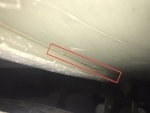gabrielp23
Member
Long story short - I bought a 1448 Grizzly All-Welded aluminum boat a couple of months ago, and despite being told by the previous owner that it didn’t leak, I discovered that it does leak. When I took it out, I was out for 2 1/2 hours and it took on about 2 gallons of water.
After some looking, I determined that the leak is coming from the bow of the boat. It appears that the aluminum c-channel that covers the keel has separated from the hull (only on the left side) in an area that is about 6-8 inches long.
How should I go about fixing this? Will marine epoxy (Marine Tex seems to be a popular choice) work since the gap is so thin? Or, is it worth having someone weld it? If so, can any one recommend a shop in NEGA that has experience welding aluminum? Luckily, there is a storage cutout in the front platform directly above the leaking area, so there is no foam in the area that would have to be removed before welding.
I was thinking about trying the epoxy first, but I’m not sure how much of a Headache it would be to remove if it doesn’t work and ends up needing to be welded.
Any advice would be greatly appreciated!
After some looking, I determined that the leak is coming from the bow of the boat. It appears that the aluminum c-channel that covers the keel has separated from the hull (only on the left side) in an area that is about 6-8 inches long.
How should I go about fixing this? Will marine epoxy (Marine Tex seems to be a popular choice) work since the gap is so thin? Or, is it worth having someone weld it? If so, can any one recommend a shop in NEGA that has experience welding aluminum? Luckily, there is a storage cutout in the front platform directly above the leaking area, so there is no foam in the area that would have to be removed before welding.
I was thinking about trying the epoxy first, but I’m not sure how much of a Headache it would be to remove if it doesn’t work and ends up needing to be welded.
Any advice would be greatly appreciated!
Attachments
Last edited by a moderator:



